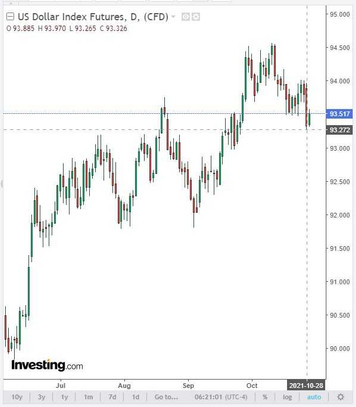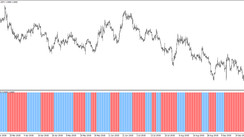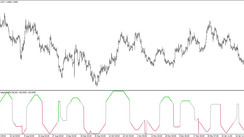The last week of this month is coming to an end, which turned out to be extremely volatile, including due to the saturation with economic news and meetings of the world's 3 largest central banks.
Yesterday, for example, a meeting of the ECB took place, which ended, as expected, with neutral decisions. The ECB leaders did not change the parameters of monetary policy: the key interest rates and the volume of the quantitative easing program remained unchanged. As follows from related statements, the ECB will keep interest rates at current or even lower levels until inflation stabilizes at the 2% target, also taking into account disruptions in global supply chains and supply shortages that are negatively affecting economic recovery of the region after the pandemic.
The results of the October meeting suggest that the ECB will lag behind other major central banks in terms of curtailing stimulus measures, despite the highest inflation rates in the region in more than 10 years. However, the head of the ECB Christine Lagarde expects inflationary pressures to ease in 2022.
At the same time, the bank expressed its intention to continue purchasing bonds "at a slightly lower pace than in the previous six months". This announcement was similar to the one made in September, but it supported the euro, which strengthened yesterday after the ECB meeting.
Next week promises to be no less interesting, with a lot of trading opportunities. The focus of market participants next week will be the publication (on Friday) of monthly data from the US labor market and the Fed meeting (November 2-3).
In addition, the central banks of Australia (on Tuesday) and the UK (on Thursday) will also hold their regular monetary policy meetings.
On the eve of the RBA meeting, the Australian dollar and the AUD / USD pair maintain positive dynamics.
In addition to rising prices for commodities and energy sources such as coal, oil, gas, which contribute to the strengthening of commodity currencies, the upward trend in AUD is also supported by upbeat macro data from Australia. Thus, the RBA core inflation index, published on Wednesday, calculated by the truncated average method, accelerated in the 3rd quarter to +0.7% (against the forecast and the previous quarterly value of +0.5%). The data showed that core inflation in Australia for the first time since 2015 returned to the middle of the target range set by the RBA.
By the way, also on Wednesday, Deputy Chairman of the Reserve Bank of Australia Guy DeBell said that the bank's monetary policy is aimed at a slight increase in inflation, but not at its long-term growth. He also noted that the Australian economy maintains strong growth dynamics and the RBA continues to observe positive trends in it.
It is possible that next year the RBA will start rolling back quantitative easing earlier than expected and will postpone the first projected rate hike to the end of 2023 from a later date.
Pressure on the RBA to adjust its forecasts for inflation and monetary policy is growing rapidly, while more central banks are fully aware of the threat of inflation in the global economy posed by rapidly rising energy prices and supply chain problems.
However, the Australian economy is expected to grow strongly in the coming months, following the lifting of lockdowns in major regions of the country. People are returning to the job market, companies are willing to hire them, and it can be assumed that the economy will soon return to full employment. If the labor market remains resilient, confidence in the acceleration of wage growth in 2022 will increase, and this is one of the main arguments for the leadership of the RBA when deciding on interest rates. The RBA would like to see wages grow at an annual rate of 3% or more. However, now the rate of their growth is about twice as slow. This is a deterrent to a decision to raise interest rates.
Thus, the intrigue around the RBA's actions remains, and much in the AUD dynamics will depend on the accompanying statements by the bank's management. In the meantime, it is expected that at this meeting, the Central Bank of Australia will leave the rate at the current level of 0.1%. In an accompanying statement, the leaders of the RBA will explain the reasons for the decision on the rate. If the RBA signals the possibility of an imminent tightening of monetary policy, the prospects for further strengthening of the AUD will increase. Recall that the publication of the RBA decision is scheduled for Tuesday at 03:30 (GMT).
Meanwhile, the US dollar is recovering its positions after falling the day before.

As of this writing, DXY futures are traded near 93.52, 25 pips above the local 4-week low of 93.27 hit Thursday following the release of US GDP data that disappointed market participants. Preliminary annual data for Q3 2021 reflected a slowdown in the US economy from +6.7% to +2.0% (the forecast assumed GDP growth of +2.7% YoY).
The fall in the dollar on Thursday could have been stronger if it were not for the optimistic weekly data from the US labor market, which reflected a decrease in the number of initial applications for unemployment benefits, from 291 thousand to 281 thousand, which turned out to be better than the forecast of 290 thousand. The number of repeated applications fell from 2.480 million to 2.243 million, which also turned out to be better than market expectations of 2.415 million.
At the same time, the US dollar is also gaining support, remaining a defensive asset amid the continuing rise in COVID-19 infections.
Today, market participants will pay attention to the publication (at 12:30 GMT) of inflation data (data on personal income / spending of Americans) for September and at 14:00 of the updated consumer confidence index from the University of Michigan for October. Its value is expected to be the same as the preliminary estimate of 71.4. Despite the fact that it is below the previous values, which are above the 80.0 mark, this is still a good result. The index is an indicator of consumer confidence in economic growth. A high result usually strengthens the USD, a low result weakens.
If the aforementioned data turn out to be worse than predicted values, then the dollar may react with a short-term sharp decline. Overall, the dollar's uptrend remains fueled by expectations that the Fed's stimulus program will soon begin to wind down (Powell signaled earlier this month that the central bank was ready to start winding up stimulus programs in November, and Fed officials indicated that they could raise interest rates next year amid risks of a more sustained-than-expected rise in inflation, unless the economy shows significant weakening).





